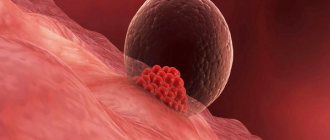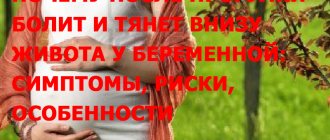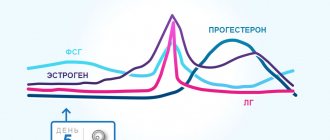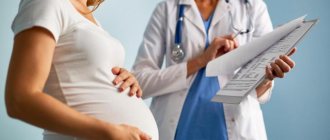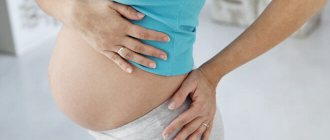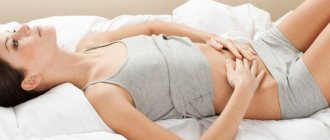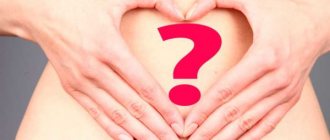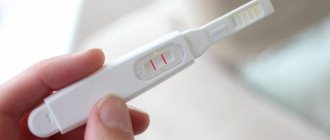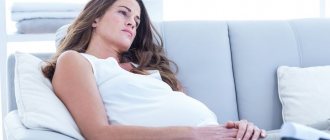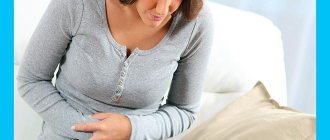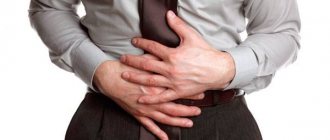Nature of pain
If you listen to what girls say about pain during ovulation that radiates to the lower back, you will find out that they rarely suffer for more than two days. How severe the unpleasant symptoms are usually varies from one woman to another.
Sometimes it is only a weak, barely noticeable stabbing sensation. In other situations they are more tugging and strongly expressed. Discomfortable sensations can be clearly localized or encircling. Not all girls experience ovulation easily, they can’t stand it and start taking painkillers. This is not justified in all cases; sometimes it is better to be patient.
This process goes unnoticed for some, while other women cannot help but notice it, as it is accompanied by headaches and lumbar pain, increased appetite, even low fever and reddish discharge.
The lower abdomen and lower back can hurt in different ways. The nature of such sensations is informative for the doctor during examination and diagnosis. If there is a possible threat of miscarriage, these pains will first be nagging, then intense; with an ectopic pregnancy, these are acute pains in the area where the fertilized egg is attached.
Ovulation is characterized by soreness in these areas for a maximum of 48 hours from its onset.
Pain before ovulation rarely occurs, since the follicle is not yet damaged and the nerve endings near it are not involved. Often pain is provoked by hormonal changes, but this is rare. In most cases, the lower back hurts before the ovulatory process due to some pathology; these pains are nagging in nature.
On the day of ovulation
My back hurts during ovulation, even after the follicle has burst. On this day, a woman may feel constant discomfort in the lower abdomen. These are nagging pains in the area of the uterus below, they can be localized in one side, and also radiate to the back to the lumbar spine.
Some patients note that the pain is not pulling, but tingling; for others, it is a cutting sensation in the right or left side that suddenly appears. Each woman subjectively feels the release of the egg.
If you have lower back pain after ovulation, this is a normal process that lasts no more than 48 hours. Otherwise, this is a reason to see a doctor. What conditions can occur with prolonged lower back pain?
- Cystitis - the bladder becomes inflamed, the woman feels pain when urinating, pulling discomfort in the lower back in a calm state.
- Inflammation of the ovary - the pain sensations differ for each woman, but they will be concentrated in the area of the problematic ovary. Possible increase in temperature.
- Cyst rupture is a dangerous condition characterized by acute pain.
- Inflammation of the intestines - a disease called colitis, the symptoms differ from the manifestations of diseases of the reproductive system. In addition to lumbar pain, symptoms such as pain when going to the toilet and possible constipation will appear.
After the follicle bursts, pain may continue due to diseases of the musculoskeletal system. This is an important point, as women forget that scoliosis is another significant cause of discomfort during ovulation. This pathology of the spine leads to distortion of organs located in the pelvic area. Their incorrect location leads to spasms during the movement of the egg through the tubes. This is accompanied by pain after ovulation.
A woman's menstrual cycle occurs in several stages. The middle phase is considered the most suitable for conception. A favorable period can be determined by various signs. Many patients complain of lower back pain during ovulation. You should know what kind of soreness is normal. If there are any abnormalities, it is necessary to undergo a medical examination.
Ovulation is the middle phase of the menstrual cycle. During this period, the egg maturation occurs, which is necessary for pregnancy. Sex cells are located in the ovaries. The reserve is laid down during intrauterine development.
Ovulation occurs under the influence of luteinizing hormone. Initially, the egg passes under the shell of the organ. A small follicle appears on the surface of the ovary. In each cycle, several follicles are formed on the ovary. A neoplasm that is larger in size is called dominant. It is he who participates in the formation of the ovulatory period.
A few days before the onset of the favorable period, hormonal changes occur. Follicle-stimulating hormone is replaced by luteinizing substance. At the peak of LH growth, an increase in follicle diameter is observed. The walls of the neoplasm cannot withstand the pressure of the follicular fluid and rupture. It is on this day that the main signs of ovulation appear.
Statistics show that 70% of patients experience aching pain in the lower back in the middle of the cycle. This time falls right in the middle of the cycle. Around days 12-14, the egg leaves the ovary, the follicle bursts, and it migrates through the fallopian tubes to the uterus.
The lower back may hurt during ovulation for various reasons, namely:
- Infections in the organs of the urinary system.
- Hormonal imbalances or adjustments.
- Distribution of atypical flora in the uterus.
- Inflammatory processes in the genitourinary system of a chronic nature.
- Degeneration of the dominant into a neoplasm of the cystic type.
- Rupture of the main follicle.
The main causes of lower back pain during ovulation include hormonal changes. This is due to the fact that when the activity of the luteinizing substance increases, smooth muscles contract. This muscle tension puts pressure on the spinal column, as a result of which the woman feels nagging pain when the follicle ruptures.
Another factor influencing the occurrence of pain in the lower abdomen and lower back during ovulation is associated with the location of the ovary and the follicle membrane. Not every girl's uterus has an ideal structure. In some of them, slight deviations of the uterine body towards the lower back can be observed. In this case, there is a possibility that the ovaries will come into contact with the muscular system of the lower back. Women with these characteristics often suffer from pain in this area.
It is very important to detect the inflammatory process in time if it is the cause of lower back pain during ovulation. Moreover, the zone of its localization is often located in the bone frame. As you know, the spine includes a system of discs and individual segments. Pain can occur due to the destruction of one of them, resulting in increased pressure on the nerve roots and the disc itself. If you do not pay attention to the problem for a long time, it will become chronic.
General symptoms
The onset of the ovulatory period can be determined in various ways: by basal temperature, using special tests, or by characteristic manifestations. Experts identify several specific ovulatory signs:
- Discharge. Follicular rupture and cell release are accompanied by the active release of the luteinizing hormonal component, under the influence of which the structural characteristics of cervical mucus change, which becomes abundant, transparent and most optimal for the advancement of sperm. It takes on the consistency of egg white and may contain several drops of blood, which is considered quite natural, because the follicle has ruptured. Usually, before ovulation, girls have no discharge, so they immediately notice the appearance of characteristic mucus.
- Breast. Usually, during the release of the egg and for some time after it, a woman experiences minor pain and swelling of the mammary glandular tissue. But this symptom is not present in all patients.
- Symptoms of a favorable period manifest themselves differently in each woman.
Libido. When a cell leaves the ovary, it begins to signal the body that it is ready to conceive, so a woman’s sex drive increases noticeably. Moreover, the increase in libido becomes so obvious that it will be enough for a woman to grasp the desires of her body.
- Painful sensations. Since the follicle ruptures during the process of ovulation, a small wound is formed, which causes painful sensations that are so insignificant that the girl may simply not notice them. Some patients experience pain in the lower back, abdomen, and sides.
Painful symptoms may persist after ovulation. There are many reasons for this phenomenon.
Some statistics
After a girl’s menstruation has become stable, after a while she begins to notice changes in her condition that occur approximately in the middle of the cycle. Usually they only concern the mammary glands, mood changes or increased sexual desire, but 20-30% of women notice that their lower abdomen hurts during ovulation. This pain is nagging in nature, varies in intensity, and is usually noted on one side.
In 85% of women, pain during ovulation is associated with natural processes. In 14% of cases, such symptoms indicate a pathology of the reproductive system. Finally, there is a small, about less than 1% probability that just during the ovulatory phase of the cycle another pathology will develop, not related to the very release of the oocyte from the follicle.
It hurts for a long time - is it dangerous or not?
It is important to eat right when planning
If pain symptoms in the lumbar and abdominal areas do not subside and last long enough, then this may indicate the development of a serious pathology, so it is impossible to do without the intervention of a doctor. There are several important points to be made. If fertilization does occur during sexual intercourse, then some pain occurs during implantation, as discussed above. This symptom usually occurs a week after ovulation.
If, when pain appears, other symptoms such as hyperthermia and nausea are present, then it is likely that there is an inflammatory lesion of some organ of the reproductive system, the development of a tumor lesion, etc. Hyperthermia indicates ovarian inflammation, and intense lumbar pain may indicate osteochondrosis, kidney disease, etc. Therefore, to clarify the source of pain, consultation with a specialist is necessary. If intense pain bothers the patient in other phases of the cycle, then there is a high probability that there is inflammatory damage to the adnexal structures, damage to the ovarian wall and other problems. Therefore, you need to consult a gynecologist as soon as possible.
The nature of pain during ovulation
At the first pain in the lower back, you should not be afraid and run to the doctor. It’s another matter if such pain lasts for more than two days. Also of concern are such manifestations of ovulation as:
- Headache and dizziness;
- I have a stomachache;
- Nausea and vomiting;
- Difficulty breathing;
- Urination brings pain.
In such a situation, you need to visit a gynecologist to understand what lower back pain and other symptoms mean. If pain in the lower back and abdomen is caused by physiologically normal characteristics of your body, analgesics will be prescribed. They will help relieve lower back pain.
Advice will also be given - to eliminate all stress factors, both physical and mental. Take a good rest, relax, think about yourself. The condition of your lower back will improve much faster if you follow these tips.
Two out of three girls suffer from uncomfortable ovulation. Usually the pain goes away quickly, but sometimes it becomes quite severe and is accompanied by other uncomfortable symptoms. If such an exacerbation is not observed, do not panic - most likely, this is a minor nuisance.
It is better not to neglect these manifestations of painful ovulation. When they appear, you should definitely visit a doctor and undergo an examination to understand why the discomfort occurs. Frequent, periodic and severe pain in the lower back during the ovulation period should alert you.
Pulling in the lower back at 39 weeks of pregnancy, what to do?
Injections for radiculitis
Pulling in the lower back at 40 weeks of pregnancy, what to do?
Pulling in the lower back at 8 weeks of pregnancy, what to do?
How to eliminate soreness
If, after the release of a female cell, a girl is bothered by nagging painful discomfort in the lumbar area, then in the absence of a pathological etiology of this symptom, such manifestations can be relieved independently. To do this, you can do a light massage with a tennis ball. To do this, take two balls and put them in a fabric bag. Then they lie on top of the balls, placing them under the lower back. You need to roll on balls, massaging the lumbar area.
- They effectively cope with ovulation and post-ovulation pain by applying heat like a bottle of warm water, a heating pad, etc. But you can only apply heat for 7 minutes. This period will be enough to relieve pain symptoms and eliminate spasms.
- If home methods do not help cope with painful discomfort, and the woman cannot stand it, then you can take antispasmodics (No-shpu) or painkillers, except for aspirin-containing drugs. NSAIDs like Ketoprofen, Ibuprofen, etc. will also help relieve pain.
- You need to rest more, get full sleep, and avoid stress and anxiety. If the pain is severe, it is recommended to provide bed rest if possible.
- To avoid intestinal disorders, which can also cause pain in the abdomen and pelvic area as a whole, it is necessary to eat properly and in moderation.
- A warm bath, to which you can add lavender oil or herbal decoction, can also help relieve pain symptoms.
Also, during painful ovulation, experts recommend avoiding sudden movements and reducing physical activity as much as possible, since the activity of nerve endings only contributes to the occurrence of painful spasms. It will also not hurt to undergo a hormonal examination, since such pain is often associated with hormonal imbalance. If painful manifestations are caused by pathological conditions, then it is necessary to undergo a medical examination; only after identifying the disease factor, the doctor will be able to prescribe optimal therapy.
Source
Ovulatory pain - normal or pathological
Minor pain during ovulation of a cutting, stabbing or cramping nature can be observed in the lower abdomen, in the area where the ovaries are located. The pain lasts about an hour, sometimes it lasts for a day or two. If you have severe pain, you should contact your gynecologist. Due to the fact that a mature follicle comes out of a different ovary every month - left or right, pain is also observed on the right or left.
Doctors explain the presence and appearance of pain during ovulation by the contraction of the uterus and fallopian tubes during the leakage of fluid from the burst follicle. After ovulation, pain is observed less frequently. Pain during or after ovulation may be associated with gynecological diseases, accompanied by pain of varying intensity and nature, with inflammation of the ovaries or other diseases of the reproductive system. Therefore, you should not ignore a visit to a specialist, attributing everything to natural symptoms of ovulation.
Increased sexual desire, caused by pain during ovulation, is like a hint from nature that the most favorable period for conception has arrived.
A woman can determine from liquid discharge that ovulation has begun. Discharge appears a few hours before ovulation and may be present for a couple of days.
The reddish and pink color of the discharge characteristic of ovulation allows you to determine the approximate days of ovulation. If the bleeding is profuse, this may be due to uterine bleeding that is dangerous for the body and you should consult a doctor.
In the absence of ovulation, pregnancy cannot occur, and hence the birth of a child.
There is no ovulation when:
- the onset of pregnancy;
- due to hormonal imbalance;
- at the onset of menopause;
- when the body reacts to taking certain medications.
The absence of ovulation is called anovulation and can be observed even in completely healthy women, when the egg does not mature in every menstrual cycle. If anovulation repeats more than three times a year, you should consult a doctor so as not to miss possible endocrine or gynecological diseases. If it is not possible to have a child due to lack of ovulation, artificial stimulation with hormonal drugs is performed. It must be carried out under the strict supervision of an experienced doctor, after conducting the necessary tests and prescribing suitable medications.
As soon as the first signs of ovulation appear, a test is performed to make sure. The test conditions are indicated on the package and are similar to performing a pregnancy test. If you suspect a lack of ovulation or to establish the exact date in each cycle, you can use a reusable digital test.
A normal menstrual cycle ends with the maturation of an egg ready for fertilization. Often this natural process is accompanied by pain. For some women, such pain goes unnoticed, for others it is a long-awaited signal about the beginning of ovulation. At the same time, the ability to distinguish pain during ovulation from pain associated with any disease will help to recognize the disease in time and consult a doctor. It is necessary to learn to recognize what causes painful sensations.
Ovulatory syndrome or pain during ovulation includes a complex of symptoms associated with the release of an egg from the follicle and is usually accompanied by pain in the lower abdomen during ovulation on one side or the other.
The main reason is the rupture of the follicle, the release of the egg, which causes pain. Minor bleeding stops on its own after 1-2 days. Very painful pain in the side during ovulation or lower back pain can be experienced by women with increased sensitivity to pain or with pelvic adhesions. Bloody discharge is explained by a drop in estradiol levels and slight endometrial detachment.
Typically, pain that occurs does not require referral to specialists. But pain in the lower abdomen in the middle of the cycle is not always evidence of ovulation. Often the pain can be associated with appendicitis. In cases of severe pain accompanied by fever that lasts more than 12 hours, you should immediately consult a doctor.
Taking painkillers prescribed by the attending gynecologist helps to cope with severe pain. Drinking plenty of fluids and a calm environment help to relax and relieve pain. Sometimes it is recommended to take oral hormonal pills as contraception and suppress ovulation.
Irritation on the abdominal wall caused by bleeding from the ovary provokes painful sensations and is the main and main cause of pain. Depending on the body and the degree of bleeding, varying degrees of pain are observed. In addition, pain is associated with the size of the distance between the ovaries and the abdominal wall. Pain during ovulation is not a pathology; it is associated with the structure of the reproductive system and physiological characteristics.
For some girls, the sensation of pain during ovulation is completely unfamiliar. Therefore, they simply do not attach importance to the appearance of mild pain in the middle of the menstrual cycle. A significant part of the female population can determine with 100% accuracy the moment of release of the egg from the follicle by the characteristic pains that regularly repeat from month to month, without any tests.
Most often, specialist attention is not required. However, you should know that not all pain can be associated with ovulation. The appearance of pain may be one of the signs of a serious illness that requires the attention of specialists. Do not hesitate to visit a doctor if:
- severe pain;
- presence of nausea or fever;
- unbearably strong pain, up to loss of consciousness;
- presence of headaches and dizziness;
- the appearance of shortness of breath, vomiting, diarrhea;
- with painful urination;
- pain lasting more than two days.
An important reason to visit a doctor is the high intensity of pain in the middle of the cycle. After the consultation, the doctor will take the most effective treatment methods.
In case of any pain, you need to pay due attention to your health. Sometimes people pay little attention to their health, do not react to the symptoms of diseases present, and do not realize that these diseases can be life-threatening. Many diseases do not manifest themselves in our body in any way from the first days, but in the end it turns out that time is lost and it is too late to treat. Each disease has its own specific signs and external manifestations, called symptoms of the disease.
The first step in diagnosing any disease is identifying the symptoms. In order to prevent a terrible disease in time, to maintain a healthy spirit in the body, it is necessary to systematically undergo medical examinations.
It would seem that pain during ovulation has every reason to develop, because the follicle containing the egg first grows to a fairly large size and then bursts, and the nerve endings approaching the ovary react to both of these processes. But usually only those who have a low pain threshold feel this normally. That is, if a woman does not tolerate pain well from childhood and may even lose consciousness because of it, she should not be alarmed by the pain of the ovulatory phase, unless 5 conditions are met:
- Ovulation is determined by tests: determination of basal temperature (its decline was noted on the previous day, and on this day a sharp rise is visible), an ovulation test or ultrasound folliculometry.
- It hurts on one side (for example, the left ovary), since in each cycle the dominant follicle, that is, the one that prepares the egg for fertilization, develops only in one ovary. Each cycle, the “working” ovary may change, but it may happen that for several months in a row the pain is felt only on one side.
- There are no pathological symptoms: dizziness, vomiting (mild nausea is allowed for 2-3 hours), weakness, or a feeling of unreality of what is happening.
- The temperature remains up to 37°C, the maximum rises to 37.3-37.4°C.
- Other symptoms of ovulation are also noted: swelling and tenderness of the mammary glands, a change in the nature of vaginal discharge to the appearance of raw egg white, and increased sexual desire. There may be a discharge of a small amount of blood (usually in the form of brown or yellowish mucus), which is associated with the detachment of a small area of the endometrium due to a sharp drop in estrogen levels.
Blood vessels approach the shell of the follicle in which the egg has matured - they provide nutrition to this structure. Therefore, when it bursts, the vessels rupture, and a small volume of blood flows into the abdominal cavity. A small amount of fluid in which the oocyte was previously located is also released. These fluids are an irritant to the peritoneal nerve endings, and therefore cause pain during ovulation.
When a woman has a low pain threshold and has 5 of the above signs, then pain in response to bleeding from the follicle vessels is a normal phenomenon that does not require any emergency measures. If the pain syndrome is very intense, or does not occupy the lower abdomen or lower back, but radiates to the left or right side, you need to be urgently examined for three conditions.
Endometriosis is characterized by the appearance of areas of the endometrium outside the inner layer of the uterus: on the uterine myometrium (adenomyosis), vagina, rectum and other locations. In this case, all ectopic foci of the endometrium react to changes in the balance of hormones and secrete a larger volume of blood than is required for ovulation. It causes pain.
The second disease that needs to be excluded when ovulation causes pain, but is not accompanied by symptoms such as weakness, dizziness, vomiting and fever is adhesive disease. In this case, bridges of connective tissue - adhesions - are formed between the internal organs. They can compress the intestines, complicated by intestinal obstruction, or the fallopian tubes, leading to infertility.
Treatment methods
You should consult a doctor when the pain after ovulation does not subside for more than three days. You also need to urgently visit a doctor if:
- There is vomiting and nausea.
- Stomach upset.
- Dizziness and shortness of breath.
- Fever.
- Painful urination.
- Migraine.
These symptoms may indicate that interruptions and disturbances are occurring in the body. And for this you need to undergo a full range of examinations. Therapy for pain syndrome can be both traditional and folk. But it is important to consult a doctor and only then begin treatment.
Traditional
If pain is present, you can use painkillers - No-shpa or Analgin. If there is an inflammatory process, the doctor prescribes non-steroidal anti-inflammatory drugs. It is worth noting that it is not recommended to take even analgesic drugs on your own, since they have a short-term effect and blur the clinical picture of the disease. If there is an exacerbation, it will be more difficult for doctors to determine what caused it.
If the situation is serious and cannot be treated with medication, the doctor may prescribe a laparoscopy. This is a surgical procedure that involves a small incision below the navel and the insertion of a special tube with an optical light to examine and identify internal tumors, cysts and other problems.
Doctors advise monitoring your cycle and keeping a special diary. You will know a few days in advance when ovulation is scheduled to occur and prepare for it - get plenty of rest, drink plenty of fluids, and don’t be nervous. In particularly painful cases, painkillers are taken.
Folk
In the fight against pain, you can also use folk recipes. Let's look at the most effective ones:
- Take one tablespoon of cinquefoil herb, put it in a saucepan with water, cover with a lid and simmer for three to four minutes over low heat. Let it sit for about ten minutes and strain. Take a quarter glass four times a day after meals.
- Take one hundred grams of heart-shaped seed and grind it in a blender or coffee grinder. Mix with the same amount of chopped walnuts and a glass of honey. Leave in the refrigerator. Eat a tablespoon morning and evening with a glass of plain water.
- For severe pain, you can also use herbal remedies. To do this, you need to take a tablespoon of raspberries and the same amount of red clover grass. Brew as tea and drink as pain occurs. For prevention, you can start taking the collection a week before ovulation.
Is lower back pain associated with ovulation?
Lower back pain occurs frequently in women. This is a symptom of many diseases of different body systems. The reproductive system is no exception. Often representatives of the fair sex experience lower back pain during ovulation. In this article, we will figure out whether the majority of the fair sex have lower back pain, whether this is normal or not, and what to do with this pain.
Lower back pain during ovulation is a common complaint at doctor’s appointments for women who have given birth or undergone surgery. Also, lumbar pain occurs during inflammatory processes in the pelvic organs. Often the woman herself does not know about the presence of such.
The birth of children, operations, inflammatory processes - all these factors lead to thickening of the thin walls of the ovary. Since the ovary is involved in ovulation, rupture of the follicle in it gives the woman discomfort and pain in the lower abdomen and lower back. This process is accompanied by the following sensations:
- the lower abdomen hurts, it is a nagging pain in nature;
- pain is localized in the area of the ovary from which the egg “came out”;
- nagging pain is also observed in the lumbar region.
The lower back feels tight and hurts during the ovulation period for no more than 2-3 days. If the pain persists, this is the beginning of a pathological process, which is diagnosed by a doctor.
Why does my lower back hurt after ovulation? This symptom may indicate pregnancy. But it’s too early to rejoice, since this symptom should not appear after conceiving a child.
Most often, pain in the lower back is a sign of a pathological pregnancy, which poses a risk to the health of the mother and the conceived child. If you suspect pregnancy with such pain, you should immediately consult a doctor.
In addition to lower back discomfort, this period is accompanied by other symptoms. A common one is increased appetite. In order not to burden your musculoskeletal system with extra pounds, you should monitor your diet when you have a strong desire to consume food.
You can help yourself survive this period without severe discomfort by following the tips described.
- Don't overeat. This is not only not aesthetically pleasing, but also not beneficial for internal organs. When a woman overeats, an illusion of health and satisfaction of food needs arises. In fact, the body gradually weakens, as toxins and waste accumulate with excess food. Doctors say that ovulation symptoms, including lower back pain, affect women with weak immunity.
- Limiting physical activity during the period of ovulation will help relieve pain in the lower back.
- Take a bath or back massage using lavender essential oil.
- To relieve the inflammatory process in the body and reduce pain in the back, you can use non-steroidal anti-inflammatory drugs that have an analgesic effect. These are Ibuprofen, Nimessil, Nimid. It is possible to use local anesthetic ointments, for example, Diclofenac or Nimid gel. They will help relieve pain in the back, and not only during ovulation.
- If your back hurts very much at the end of the day, you need to lie in a horizontal position so that the load is distributed evenly across the entire spine.
A woman’s cycle may be accompanied by discomfort in the lower back, but if it increases and lasts more than 3 days, you should consult a specialist for further examination.
You should definitely undergo an examination and rule out serious diseases if you have the following symptoms:
- severe nausea and/or vomiting;
- weakness;
- temperature increase;
- loose stool;
- dizziness.
If the pain is intense, requires taking a certain position of the body, is localized in the right side, hospitalization in a surgical or gynecological hospital is required, because this can manifest not only appendicitis, but also ovarian apoplexy, torsion of the pedicle of an ovarian cyst, acute inflammation of the uterine appendages.
A painful ovulatory phase is a sign of a disease in the presence of the following conditions:
- algodismenorrhea;
- heavy menstruation;
- pain during sexual intercourse;
- contact bleeding;
- lack of libido;
- disturbances in the basal temperature chart.
In this case, you need to visit a gynecologist as soon as possible.
Sometimes a woman worries that she is experiencing pain before ovulation, but in fact, due to physiological or pathological reasons, the moment of release of the egg occurred earlier, that is, in fact, she is now ovulating.
Physiological reasons for the shift in the ovulatory phase include: stress, acute illnesses and exacerbation of chronic pathologies, time zone changes. Ovulation can also shift due to inflammatory diseases, endometriosis, and endocrine diseases that have developed in the uterine appendages (pathologies of the adrenal glands, hypothalamus, pituitary gland).
If your stomach hurts before ovulation, and this is clearly visible from the basal temperature graph or folliculometry data, the symptom indicates the presence of various pathologies:
- growing uterine fibroids, manifested, in addition to constant pain, by bleeding from the vagina during the intermenstrual period, as well as longer and heavier menstruation;
- the development, immediately before the release of the oocyte, of inflammation of the uterine appendages (salpingoophoritis), intestines or urinary organs, each of which is complemented by characteristic symptoms.
If a patient complains of pain in the lumbar region that occurs after ovulation, the doctor needs to conduct a differential diagnosis of conditions such as:
- threat of miscarriage;
- uterine fibroids;
- rupture of an ovarian cyst;
- appendicitis;
- pyelonephritis;
- intestinal inflammation;
- cystitis.
Why does this particular area hurt? This is explained by the fact that the nerve endings that go to the uterus and its appendages, lower intestines, bladder and kidneys have common “roots”, so the impulse coming from the diseased organ is “dissipated” throughout all innervated structures.
The doctor should tell you what to do in case of painful ovulation after a complete examination of the patient. He determines the diagnostic plan, and based on the data obtained as a result of the examination, he can tell whether the pain accompanying the release of the oocyte is a physiological process or is associated with a pathological condition.
If the pain of the ovulatory phase is pathological, the doctor prescribes appropriate treatment. This is the prescription of oral contraceptives, anti-inflammatory drugs, antibiotics; in some cases, surgery is indicated.
When pain during ovulation appears for natural reasons, to alleviate the condition, the doctor will prescribe:
- Painkillers: Ibuprofen, Tamipul, Diclofenac, Solpadeine - depending on the severity of pain.
- Antispasmodics: “No-shpu”, “Spazmalgon”, “Baralgin”.
- Avoid physical activity and heat on the abdominal area.
You can help yourself survive this period without severe discomfort by following the tips described.
A woman’s cycle may be accompanied by discomfort in the lower back, but if it increases and lasts more than 3 days, you should consult a specialist for further examination.
When should you see a doctor?
If pain constantly appears in the back area during ovulation and menstruation, it is better to consult your doctor. Remember that the appearance of pain can be provoked by all kinds of diseases and pathological processes. Moreover, they may be associated with the pelvic organs or have a different nature.
You should not rely only on painkillers. Remember that their main goal is to relieve pain, not eliminate its cause. If severe pain occurs over several cycles, you should visit a specialist, who needs to be told exactly about the pain manifestations.
The doctor will refer you for tests and examinations that will identify the factors causing poor health. As a result of an individual treatment regimen, the pain will go away over time. Thus, a correct diagnosis helps to quickly resolve the problem.
Why does pain persist after ovulation?
If the ovary hurts after ovulation, this indicates the development of one of the following conditions:
- Follicular cyst. Here, the pain syndrome is caused by the “attempts” of the follicle to burst and release the egg. The pain intensifies during sexual intercourse, sudden movements, and physical activity. Complications of a follicular cyst are torsion of its legs and rupture of its membranes.
- The rupture of an ovarian cyst is accompanied by severe sharp pain in the lower abdomen, which radiates to the rectum, navel or lower back. Against this background, weakness increases, dizziness develops, and loss of consciousness may develop.
- Torsion of the vascular pedicle of the cyst. Her symptoms are no different from the previous condition.
- Uterine fibroids described above.
- Adnexitis. In this case, quite intense pain in the abdomen occurs, which can lead the woman to the operating table. The temperature rises, a headache develops, and copious discharge appears from the genital tract, often of a mucopurulent nature.
- Premenstrual syndrome, in which the amount of progesterone in the blood decreases. This leads to abdominal pain “like menstruation”, while menstruation itself does not occur for a long time.
- An ectopic pregnancy, even before the appearance of general symptoms indicating conception, can manifest as pain in the lower abdomen. This is how the fallopian tubes react to being stretched by the growing embryo.
- Development of menopause. For various reasons, menopause may begin not at 40-45 years of age, but earlier (early menopause). Soreness after ovulation is one of its first manifestations, then a decrease in menstruation, hot flashes, headaches, and sweating will be noted.
How long can the pain last?
If the pain does not go away after 2-3 days, then most likely its cause is a pathological factor:
- Cystitis.
- Inflammatory process in the ovary.
- Cyst rupture.
- Intestinal inflammation.
- Salpingitis, endometriosis.
- Appendicitis.
- Inflammation of the abdominal organs, etc.
In case of prolonged painful manifestations, there is no need to hesitate to visit a doctor. Only a specialist can determine the exact cause of pathological symptoms. The pain that is caused by ovulation does not last longer than 3 days, you should not forget about this.
If after ovulation fertilization of the egg by sperm does not occur, all symptoms subside. With ongoing pain in the lumbar region, nagging pain in the abdomen, only a doctor can tell what is the reason for this situation.
Unbearable pain accompanied by bleeding indicates an ectopic pregnancy. The embryo, attached to the fallopian tube, stretches it as it grows, which eventually leads to rupture. In this case, the patient will require surgical intervention.
Main causes of pain
Interestingly, severe pain can occur not only in the middle of the menstrual cycle.
Often pulls the lower back at the end of the cycle. There are several main causes of pain:
- decrease in estrogen;
- increase in progesterone levels;
- a significant increase in the amount of prostaglandins;
- various negative processes in the uterus;
- multiple increase in thyroid activity;
- use of intrauterine contraceptives.
Changes in estrogen levels are the most common cause of pain. The characteristics of the uterus and the sensitivity of a woman are largely determined by hormonal levels. A significant increase in estrogen levels can often be observed in women over 37 years of age. After this age, menstrual flow begins to be especially painful.
Ectopic pregnancy
In the case when a fertilized egg is not able to move into the uterine cavity for further development, it settles on the wall of the fallopian tubes . Every day the cells divide, and the embryo increases in size, stretching the fallopian tube. Irritation of the nerve endings leads to an increase in pain, and when the embryo is several times larger than the parameters of the fallopian tube, the pain becomes unbearable.
This phenomenon is extremely dangerous for the body, as it can cause pipe rupture and internal bleeding, which is a threat to life.
Therefore, after the onset of delayed menstruation, it is important to pay attention to such indicators as intense pain in the lower back and lower abdomen. Type of pain: Aching and bursting in the initial stages and sharp and shooting in the long term. Pain may be accompanied by a decrease in activity, as well as an increase in body temperature. Localization: The lumbar and hypochondrium area, as well as the lower abdomen. Diagnostics It is important to note that a blood test for ectopic pregnancy shows quite acceptable levels of the hCG hormone (pregnancy hormone), so it is not taken into account when diagnosing. The condition of the uterine cavity is assessed, and if there is no embryo in it, the fallopian tubes are examined.
Upon palpation, a significant increase in the diameter of the pipe is diagnosed, as well as a characteristic bulging in a separate area.
Treatment In this case, it is not possible to maintain the pregnancy, and treatment is exclusively surgical. Depending on what stage of development the embryo is at and how strongly it grows into the cavity of the tube, surgical intervention can be of two types:
- Tubotomy - used in the early stages of pregnancy, when there is no threat of rupture of the tube itself. A small size is produced at the site of the fertilized egg, after which all its contents are removed. Further treatment is aimed at eliminating the inflammatory process, as well as restoring the woman’s reproductive function.
- Resection of the tube with the ovary is performed when an extensive inflammatory process develops. The embryo is removed along with the tube and ovary, which significantly reduces the woman’s ability to conceive a child in the future.
What to do
Often women who have lower back pain in the middle of the cycle try to “tough it out” or take painkillers. This is the wrong way. Severe lower back pain is a serious symptom that cannot be ignored.
Could it happen that the pain after ovulation will disappear on its own and the help of a doctor will not be needed? The process of pulling the lower back after ovulation on the 3-4th day from the release of the gamete from the follicle most often does not bode well and, as a rule, ends in hospital treatment. You should not hope for the spontaneous disappearance of pathological symptoms. It is better to immediately contact a specialist who will conduct a competent diagnosis of the condition, determine the causes of the pain and prescribe adequate therapy.
During certain periods of the menstrual cycle, a woman may experience sensations of a different nature. Pain in the first days of menstruation is considered natural and does not cause concern, but its appearance at other periods of time makes you perplexed and alarmed, such as when, after ovulation, the lower abdomen and lower back are pulled.
Why is this happening
Why does my lower back hurt after ovulation? The reasons for this condition lie in the peculiarities of the structure and functioning of the genital area in women. Namely, in the process of maturation of the egg in the follicle and its release from the ovary. The time period during which the mature sexual gamete leaves its former habitat and is sent to the fallopian tube is called ovulation. It occurs 12-16 days after the start of menstruation, so many women experience lower back pain in the middle of the cycle.
As you know, the release of a mature egg into the abdominal cavity is accompanied by swelling of the burst follicle and small, imperceptible, absolutely harmless bleeding, which can irritate the peritoneum and be the reason why the lower back hurts during ovulation. Naturally, such painful sensations are minimal. They quickly go away and are forgotten. Sometimes women don’t even attach any importance to them and continue to lead their usual lifestyle.
Keep in mind that sometimes aching pain in the back and lower abdomen can be symptoms of pregnancy.
If there is a possibility of conception, act as if you are pregnant before your period begins. Do not take medications that are contraindicated in the first trimester. Avoid stress, alcohol, get more rest. Start taking folic acid (even if you find out that the “alarm” is false, this vitamin will not hurt). On the first day of your missed period, you can take a pregnancy test.
Pain as evidence of pregnancy
If contact is successful, the fertilized egg moves forward and penetrates the endometrium of the uterus. During implantation, several vessels in the lining of the uterus rupture, which can be felt by some girls. So, if a week has passed since ovulation and your lower back is tightening again, this is most likely an early sign of pregnancy. Additional evidence of the fact at this stage is considered:
- swollen breasts;
- slight bleeding from the vagina in the form of 1-2 drops of blood;
- pain is felt on the 7th day after ovulation (pulling the lower back, the bottom of the cavity in the front part hurts).
This means that the embryo has implanted into the endometrial wall. After 1-2 days, all these painful signs disappear and are replaced by the usual, more pronounced symptoms of pregnancy: mood swings, aversion to familiar foods and smells, changes in appetite, mild malaise, etc.
